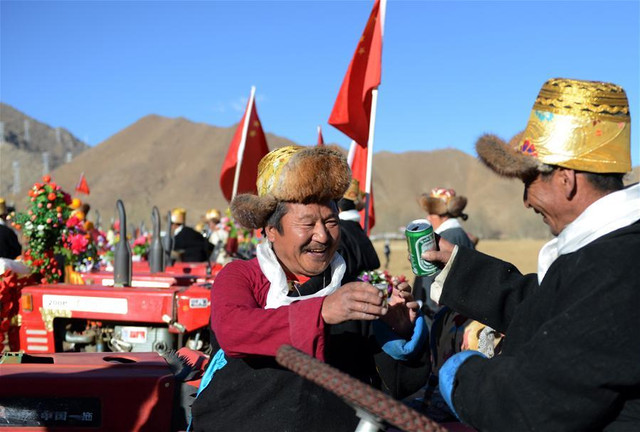Tibet is a land steeped in tradition, where rituals and customs play an essential role in everyday life. Visitors who wish to experience Tibet’s unique spiritual and cultural atmosphere must first understand the nuanced etiquettes that define Tibetan society. From the symbolic act of sprinkling Zanba to the respectful exchange of oaths, Tibet’s etiquette system is as intricate as it is profound. This article explores several traditional practices, offering insights into the behaviors that have been passed down over generations and remain integral to Tibetan identity.

Sprinkling Zanba: A Symbol of Blessing
In regions like Shigatse, the practice of sprinkling Zanba—a flour mixture made from wheat, barley, and peas—is a cherished custom. Zanba, a staple food rich in history and symbolism, is not only an everyday nutritional source but also a symbol of auspiciousness and prosperity.
When a guest is about to leave, the host gently pinches a small amount of Zanba and sprinkles it onto the guest’s shoulder. This heartfelt gesture carries wishes for a happy family life, success, and continued good fortune. The ritual is especially prominent during major festivals or the traditional new year, when family members and friends gather to celebrate and share blessings with one another. Such acts of kindness serve as both an expression of hospitality and a deep-rooted cultural affirmation of communal bonds.
The Tibetan Oath: A Sacred Promise
In Tibetan culture, giving one’s word is a matter of solemn commitment and moral gravity. Traditional oaths in Tibet are not taken lightly. Historical practices even illustrate dramatic rituals from ancient times—where oaths were sealed by sacrificing animals and performing complex gestures before invoking the judgment of the cosmos. Although these dramatic methods have evolved, the significance of an oath remains intact.
Tibetans may swear their promises in two distinct ways: orally and through symbolic gestures. An oral oath might invoke the authority of revered religious figures or institutions. Phrases like “Gong jue song” signify that the vow is made under the revered banner of the Triratna (Buddha, Dharma, and Sangha), whereas “Qiao ren bu” alludes to the honor of Buddha Sakyamuni. Alternatively, some oaths call upon the power of local deities or the sacredness of familial bonds, emphasizing that not only the individual’s honor but that of their kin is at stake should the vow be broken.
Taking an oath using gestures or religious symbols adds another layer of solemnity. Examples include placing a Buddhist scripture on one’s head or bowing deeply before sacred statues. In this way, the act of swearing is inseparable from Tibet’s spiritual heritage, reinforcing the sacred bond between personal integrity and community expectations.
Respectful Address: Titles and Terms of Deference
Respect permeates every layer of Tibetan society, and language serves as the primary conduit for displaying this reverence. In central Tibetan regions such as Lhasa, Shigatse, and Shannan, the proper use of honorifics is essential. It is common practice to append the respectful suffix “-la” to a person’s name. For instance, Ge Sang becomes “Ge Sang La,” while Tshi is respectfully referred to as “Tshi La.” Such linguistic etiquette not only reflects one’s upbringing and manners but also underscores one’s understanding of social hierarchies and traditions.
Using appropriate terms of address is critical; those who misuse these honorifics or omit them altogether may be seen as impolite or even disrespectful. Thus, polite conversation in Tibet often goes beyond the content of the words—it is about engaging with someone in a manner that upholds the dignity and centuries-old customs of Tibetan culture.
Gift-Giving: An Art of Reciprocity
In Tibetan social gatherings, the act of giving and receiving presents is highly ritualized. Gifts are usually exchanged during significant festivals or ceremonies, and this practice is integral to reinforcing relationships. When a host presents a gift to a visitor, it is expected that the guest reciprocates, often with a gesture that involves more items than were initially offered. This reciprocity symbolizes mutual respect and the unspoken rules of social balance in Tibetan traditions.
The presentation of gifts is carried out with a great deal of ceremony. As guests depart from a family’s home, family members typically stand to honor the occasion. Instead of the guest taking the gift immediately, the host often wraps the item and sees it off with warm regards. This careful exchange of gifts is designed to maintain social harmony and conveys the message that generosity, when properly reciprocated, strengthens communal ties.
Family Values: Children and Parental Respect
Family bonds in Tibet are deeply entrenched in the values of respect and honor. From a young age, children are taught to honor their parents and elders. This respect is demonstrated not only through obedience but also through acts of service. A child might greet returning parents or elders with a bow, assist by carefully arranging their belongings, or prepare tea and wine as tokens of respect. In Tibetan households, it is vital that children avoid any behavior—such as interrupting conversations or occupying a parent’s reserved seat—that could be interpreted as discourteous.
By adhering to these customs, children learn early on that familial respect is the bedrock of social interaction. In Tibet, filial piety is not just an expectation; it is a way of life that preserves the family’s honor and ensures that wisdom is passed down through generations.
Hospitality: Etiquette When Welcoming Guests
Hospitality in Tibet is a well-honed art form. Even strangers are warmly welcomed with tea, drinks, and, of course, Zanba. The host, often with a respectful bow and open hands, steps forward to greet guests at the doorway, ensuring that the visitors feel the full embrace of Tibetan warmth. When the guests finally enter the home, the host leads them to their seats, arranging everyone carefully with men typically seated on the left and women on the right.
In many Tibetan homes, a special ritual precedes the consumption of tea or other beverages. For example, guests may be required to dip their ring finger into the cup and flick a few drops of the drink as an homage to the Triratna—an act that is both symbolic and steeped in centuries of tradition. All these rituals help set the tone for an encounter that is as gracious as it is culturally rich, underlining that every gesture and every shared drink carries a blessing.
Teacher-Student Etiquette
Respect for authority is a cherished value in Tibetan culture, especially evident in the relationship between teachers and students. The title “teacher” is regarded as almost sacred, symbolizing wisdom, experience, and moral integrity. When a teacher enters a room, it is customary for everyone to remove their hats, hold them at chest level, and bow respectfully. The teacher is allowed to speak or act before anyone else, and family members will often open curtains or step aside to pay homage. Students may also be required to serve tea and wine, ensuring that the teacher’s comfort is paramount.
Senior-Junior Etiquette
Similarly, Tibetans place great emphasis on interactions between seniors and juniors. It is customary for the senior person to be served first—whether it be walking ahead, occupying the best seating, or initiating conversation. Juniors are expected to follow the lead of their elders, addressing them with utmost courtesy and reverence. Breaking these rules of seniority is seen not only as a breach of etiquette but also as a disregard for the accumulated wisdom and experience that the elder represents.
Understanding and adhering to Tibetan etiquette opens the door to a deeper appreciation of Tibet’s unique culture. Whether it is the time-honored act of sprinkling Zanba, the gravity of taking an oath, or the meticulous rules surrounding gift-giving and respectful address, every custom is a mirror reflecting centuries of tradition and a society that places immense value on honor, respect, and community. These practices are not mere formalities—they are the living expressions of a people whose traditions have been safeguarded and passed down through generations.
As visitors immerse themselves in the warmth of Tibetan hospitality, they discover that observing these etiquettes is more than complying with social norms—it is a way of connecting with a rich cultural tapestry that honors both the individual and the community. Embracing Tibetan etiquettes not only enriches the travel experience but also fosters a respectful dialogue between visitors and the ancient traditions of this mystical region.
Once you understand these Tibetan etiquettes, you can start your Tibet trip with Journey2tibet. View Tibet Tour Packages.











